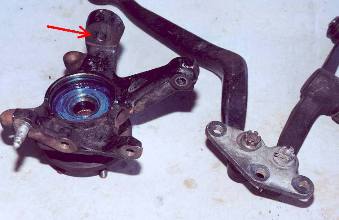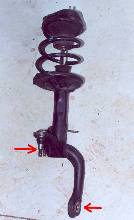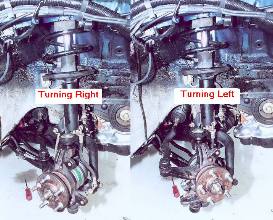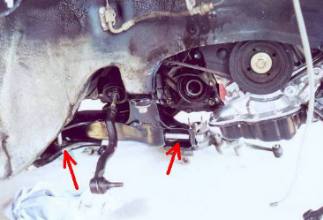ST205 Superstrut Suspension
![]()
The ST205 GT-Four uses a system of front suspension design unique to Toyota. It moves away from the MacPherson strut used on all other Celicas and is much more complex. This system is used on the GT-Four, some Japanese spec Corollas and the higher spec Japanese fwd Celicas (SSII and SSIII). It was available in Europe on the Carina GTi and was an option on the ST202 (thanks Dirk for the info).
My understanding of the system is that the geometry does not give the same camber and castor changes during cornering that occur with MacPherson strut. Is it better? Well, it is different. There are reliability problems if maintenance isn't kept up, TTE had continual problems and I believe they swapped the rally cars back to MacPherson strut.
A brief description of MacPherson strut is in order. The Toyota system uses a lower A arm with rubber bushings front and rear. This has only one degree of motion (ie. it rotates on the bushings). At the outer point of the A arm is a balljoint which connects to the steering knuckle and allows for rotation (steering) and pivot (shock compression). The steering knuckle is rigidly bolted to the bottom of the strut. The whole strut turns when steering, twisting in the roller bearing in the top mount. Fairly simple and cheap, used by most manufacturers.
So what is Superstrut suspension? It is a hybrid between normal MacPherson strut and a multilink setup. One of the requirements of the design brief was that the system would fit existing suspension mount locations. Therefore the system can be fitted into export Celicas as well as the Japanese lower spec SSI! The late production cars even share the same subframe.
The photo below shows the lower part of the system. This consists of a front and rear lower arm, connected (by rodends) to a connector plate. The rear arm has a rubber bushing at the inner end (the only rubber bushing at the front except swaybar D-bushings), the front arm has a balljoint. This system allows the arms to pivot as the suspension turns.

The steering knuckle is quite different to that of the MacPherson strut cars. It bolts securely to the connector plate joining the lower arms (see photo below). The top end connects to the strut part way up using a balljoint (see red arrow in left picture and upper arrow in right picture below. The strut mounts to the body in the normal way, but the lower end is secured to the front lower arm using another pivoting arm visible at the right in the photo above. This arm is near vertical in the photos, it is actually about 150mm long and pivots at each end.
 |
 |
The photo of the assembled suspension below
shows that the strut rotates minimally when steering ( the same amount as the front lower
arm as it is rigidly connected). The steering knuckle moves instead. While the
outboard strut moves rearwards slightly when the car turns in (turning left in the photo),
it can be seen that the hub moves forward. But because of the strut movement
the actual movement at the wheel is minimised.
The second photo shows the mounting points for the lower arms on the subframe.
 |
 |
|
![]()
![]()